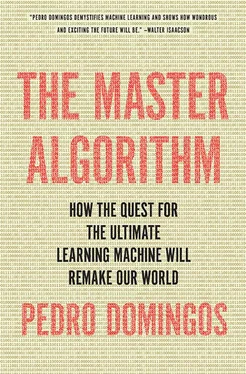Markov networks can be trained to maximize either the likelihood of the whole data or the conditional likelihood of what we want to predict given what we know. For Siri, the likelihood of the whole data is P(words, sounds) , and the conditional likelihood we’re interested in is P(words | sounds) . By optimizing the latter, we can ignore P(sounds) , which is only a distraction from our goal. And since we ignore it, it can be arbitrarily complex. This is much better than HMMs’ unrealistic assumption that sounds depend solely on the corresponding words, without any influence from the surroundings. In fact, if all Siri cares about is figuring out which words you just spoke, perhaps it doesn’t even need to worry about probabilities; it just needs to make sure the correct words score higher than incorrect ones when it tots up the weights of their features-ideally a lot higher, just to be safe.
Analogizers took this line of reasoning to its logical conclusion, as we’ll see in the next chapter. In the first decade of the new millennium, they in turn took over NIPS. Now the connectionists dominate once more, under the banner of deep learning. Some say that research goes in cycles, but it’s more like a spiral, with loops winding around the direction of progress. In machine learning, the spiral converges to the Master Algorithm.
Logic and probability: The star-crossed couple
You’d think that Bayesians and symbolists would get along great, given that they both believe in a first-principles approach to learning, rather than a nature-inspired one. Far from it. Symbolists don’t like probabilities and tell jokes like “How many Bayesians does it take to change a lightbulb? They’re not sure. Come to think of it, they’re not sure the lightbulb is burned out.” More seriously, symbolists point to the high price we pay for probability. Inference suddenly becomes a lot more expensive, all those numbers are hard to understand, we have to deal with priors, and hordes of zombie hypotheses chase us around forever. The ability to compose pieces of knowledge on the fly, so dear to symbolists, is gone. Worst of all, we don’t know how to put probability distributions on many of the things we need to learn. A Bayesian network is a distribution over a vector of variables, but what about distributions over networks, databases, knowledge bases, languages, plans, and computer programs, to name a few? All of these are easily handled in logic, and an algorithm that can’t learn them is clearly not the Master Algorithm.
Bayesians, in turn, point to the brittleness of logic. If I have a rule like Birds fly , a world with even one flightless bird is impossible. If I try to patch things by adding exceptions, such as Birds fly, unless they’re penguins , I’ll never be done. (What about ostriches? Birds in cages? Dead birds? Birds with broken wings? Soaked wings?) A doctor diagnoses you with cancer, and you decide to get a second opinion. If the second doctor disagrees, you’re stuck. You can’t weigh the two opinions; you just have to believe them both. And then a catastrophe happens: pigs fly, perpetual motion is possible, and Earth doesn’t exist-because in logic everything can be inferred from a contradiction. Furthermore, if knowledge is learned from data, I can never be sure it’s true. Why do symbolists pretend otherwise? Surely Hume would frown on such insouciance.
Bayesians and symbolists agree that prior assumptions are inevitable, but they differ in the kinds of prior knowledge they allow. For Bayesians, knowledge goes in the prior distribution over the structure and parameters of the model. In principle, the parameter prior could be anything we please, but ironically, Bayesians tend to choose uninformative priors (like assigning the same probability to all hypotheses) because they’re easier to compute with. In any case, humans are not very good at estimating probabilities. For structure, Bayesian networks provide an intuitive way to incorporate knowledge: draw an arrow from A to B if you think that A directly causes B. But symbolists are much more flexible: you can provide as prior knowledge to your learner anything you can encode in logic, and practically anything can be encoded in logic-provided it’s black and white.
Clearly, we need both logic and probability. Curing cancer is a good example. A Bayesian network can model a single aspect of how cells function, like gene regulation or protein folding, but only logic can put all the pieces together into a coherent picture. On the other hand, logic can’t deal with incomplete or noisy information, which is pervasive in experimental biology, but Bayesian networks can handle it with aplomb.
Bayesian learning works on a single table of data, where each column represents a variable (for example, the expression level of one gene) and each row represents an instance (for example, a single microarray experiment, with each gene’s observed expression level). It’s OK if the table has “holes” and measurement errors because we can use probabilistic inference to fill in the holes and average over the errors. But if we have more than one table, Bayesian learning is stuck. It doesn’t know how to, for example, combine gene expression data with data about which DNA segments get translated into proteins, and how in turn the three-dimensional shapes of those proteins cause them to lock on to different parts of the DNA molecule, affecting the expression of other genes. In logic, we can easily write rules relating all of these aspects, and learn them from the relevant combinations of tables-but only provided the tables have no holes or errors.
Combining connectionism and evolutionism was fairly easy: just evolve the network structure and learn the parameters by backpropagation. But unifying logic and probability is a much harder problem. Attempts to do it go all the way back to Leibniz, who was a pioneer of both. Some of the best philosophers and mathematicians of the nineteenth and twentieth centuries, like George Boole and Rudolf Carnap, worked hard on it but ultimately didn’t get very far. More recently, computer scientists and AI researchers have joined the fray. But as the millennium turned around, the best we had were partial successes, like adding some logical constructs to Bayesian networks. Most experts believed that unifying logic and probability was impossible. The prospects for a Master Algorithm did not look good, particularly since the existing evolutionary and connectionist algorithms couldn’t deal with incomplete information or multiple data sets, either.
Luckily, we have since cracked the problem, and the Master Algorithm now looks that much closer. We’ll see how we did it in Chapter 9 and take it from there. But first we need to gather a very important, still-missing piece of the puzzle: how to learn from very little data. That might seem unnecessary in these days of data deluge, but the truth is that we often find ourselves with reams of data about some parts of the problem we want to solve and almost none about others. This is where one of the most important ideas in machine learning comes in: analogy. All of the tribes we’ve met so far have one thing in common: they learn an explicit model of the phenomenon under consideration, whether it’s a set of rules, a multilayer perceptron, a genetic program, or a Bayesian network. When they don’t have enough data to do that, they’re stumped. But analogizers can learn from as little as one example because they never form a model. Let’s see what they do instead.
CHAPTER SEVEN: You Are What You Resemble
Frank Abagnale Jr. is one of the most notorious con men in history. Abagnale, portrayed by Leonardo DiCaprio in Spielberg’s movie Catch Me If You Can , forged millions of dollars’ worth of checks, impersonated an attorney and a college instructor, and traveled the world as a fake Pan Am pilot-all before his twenty-first birthday. But perhaps his most jaw-dropping exploit was to successfully pose as a doctor for nearly a year in late-1960s Atlanta. Practicing medicine supposedly requires many years in med school, a license, a residency, and whatnot, but Abagnale managed to bypass all these niceties and never got called on it.
Читать дальше












